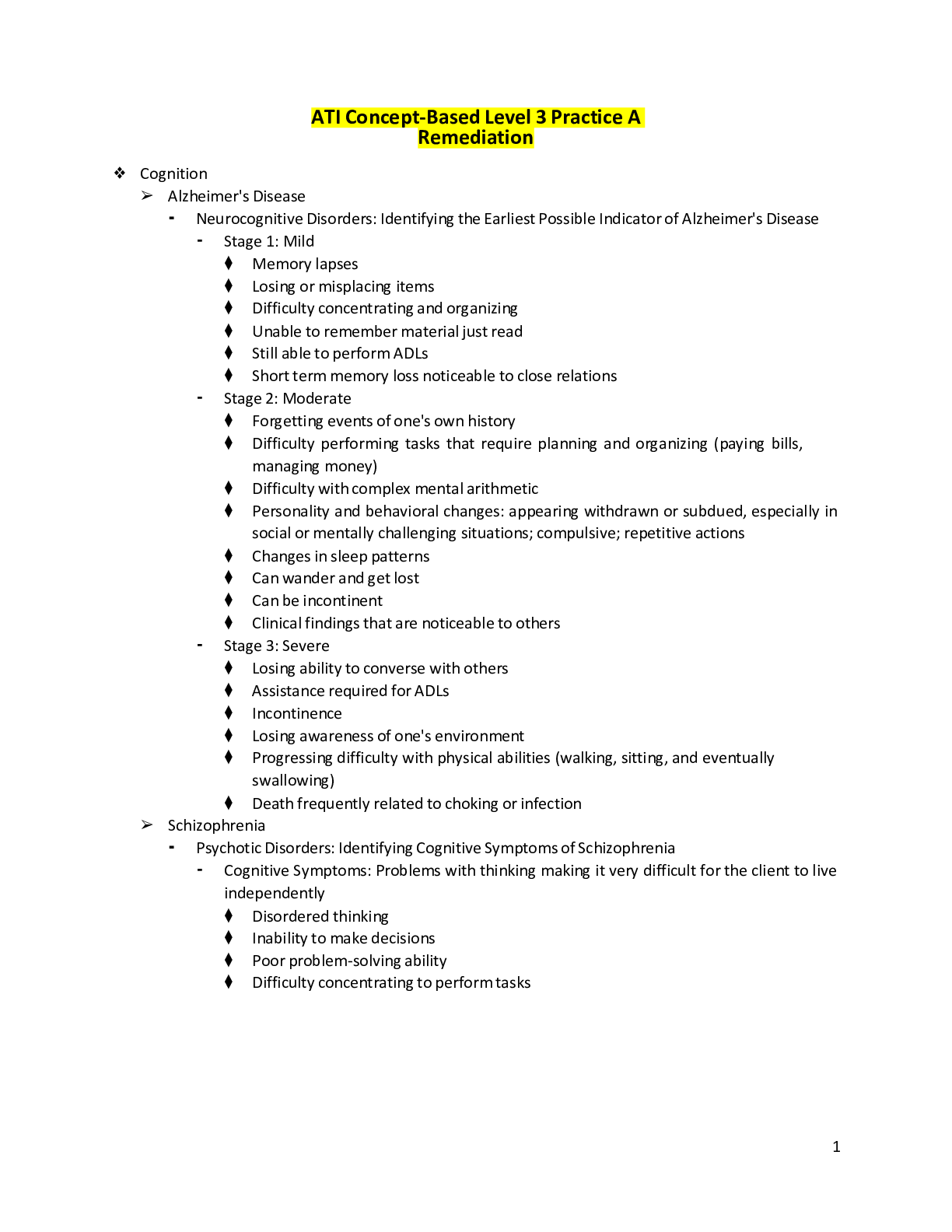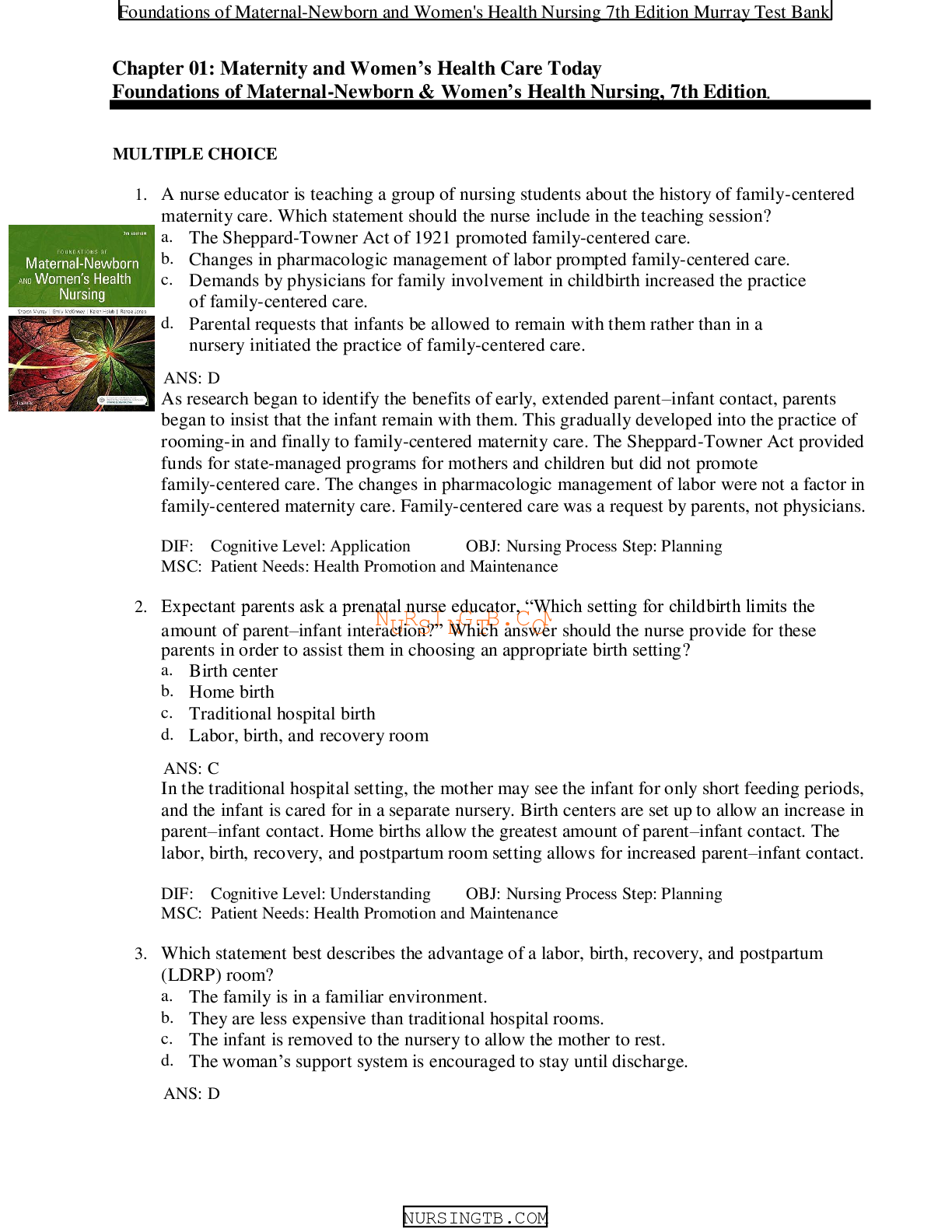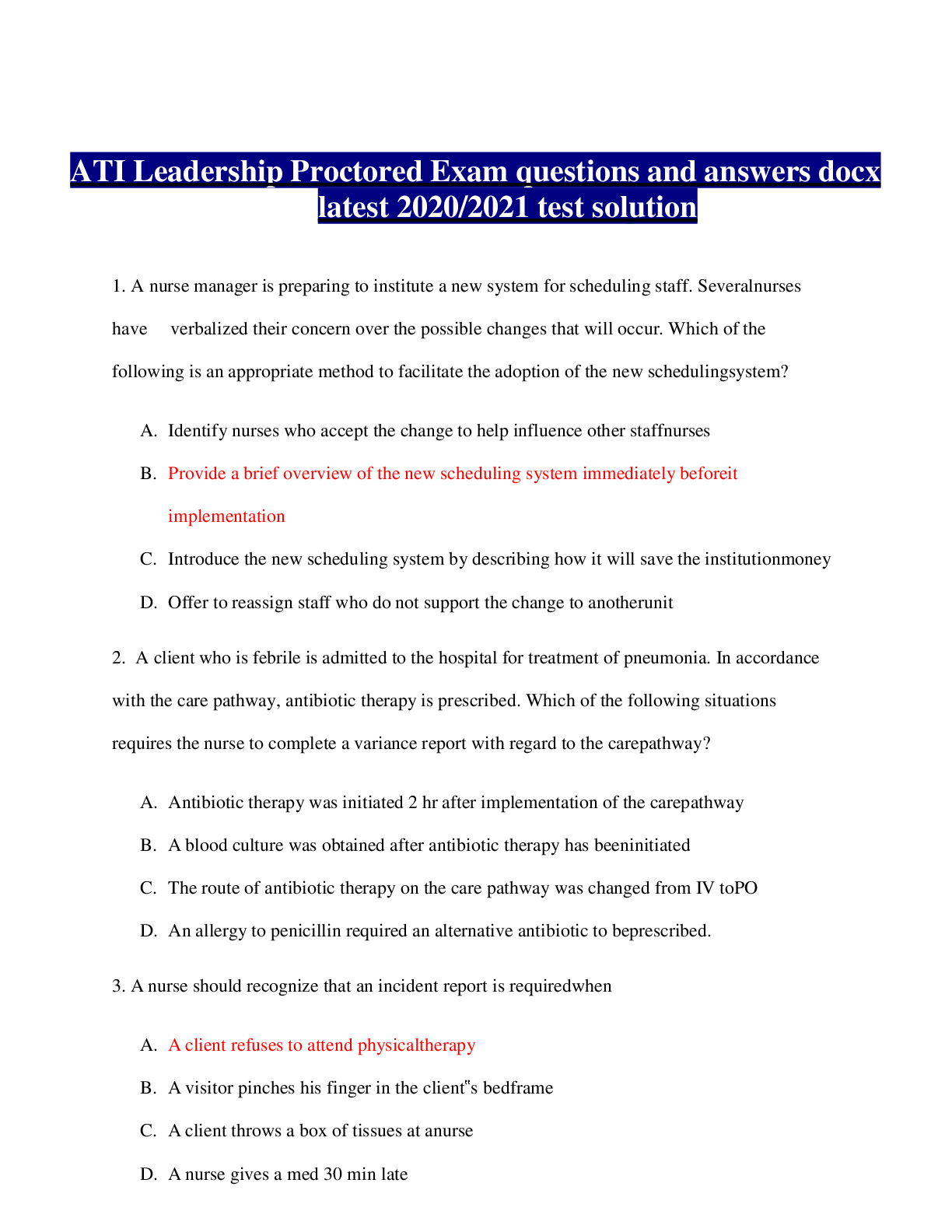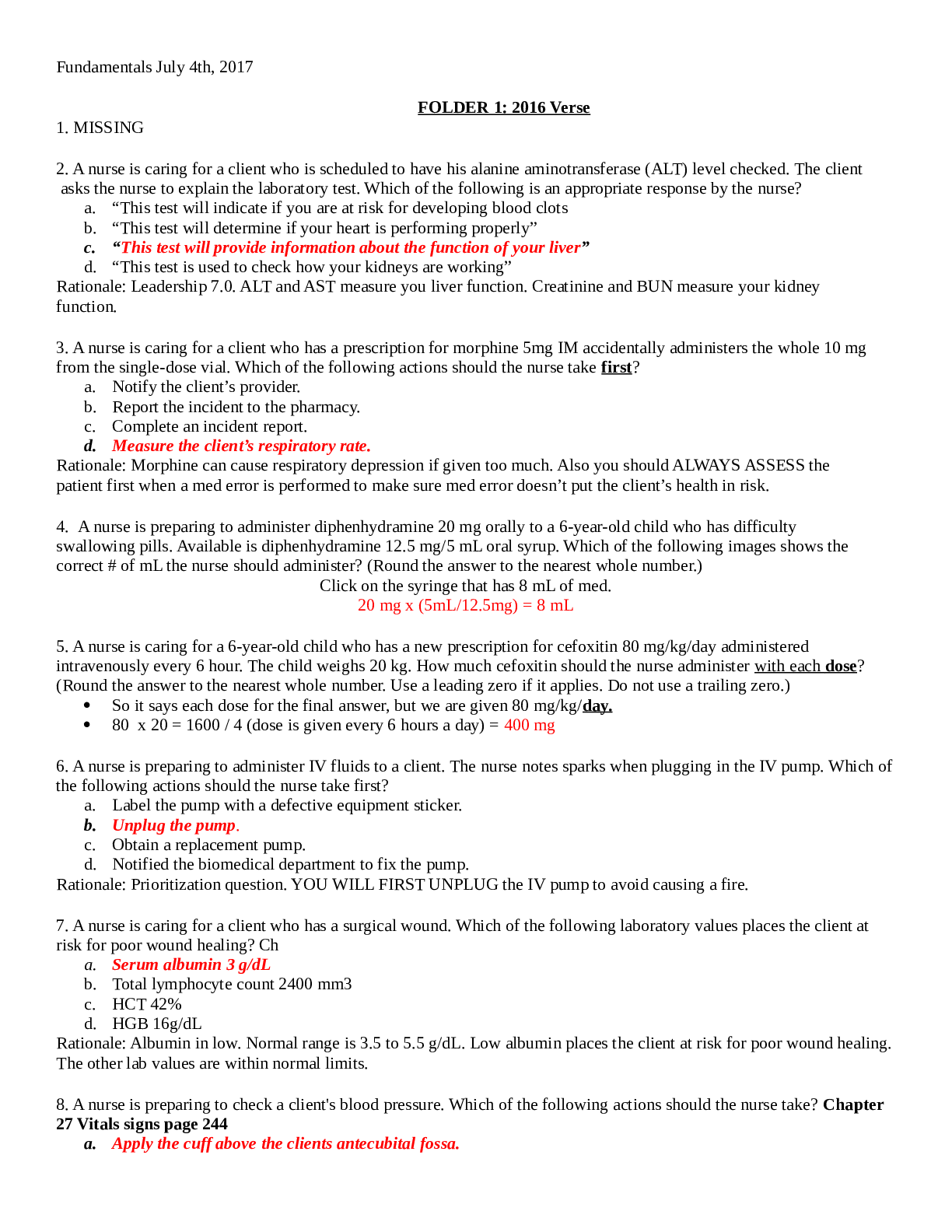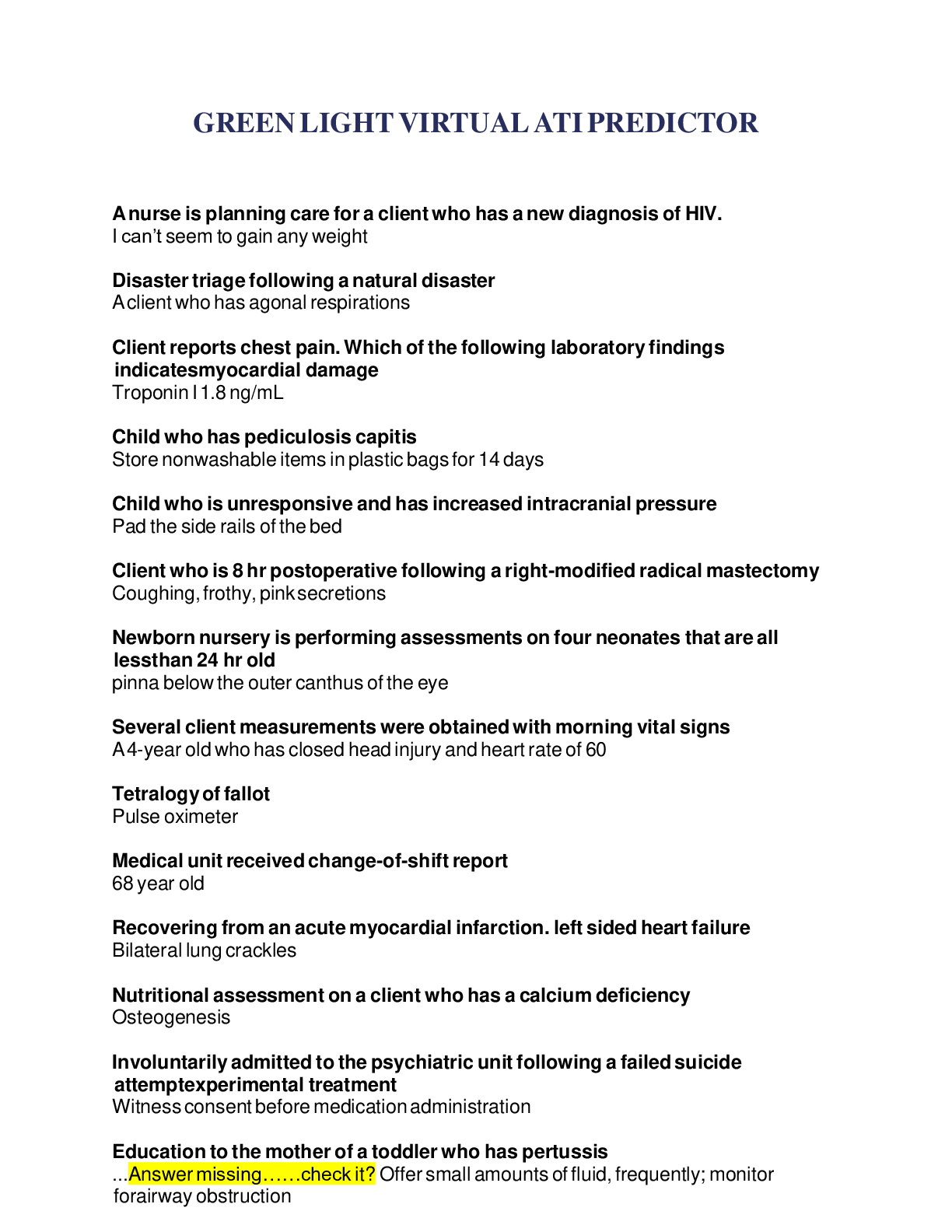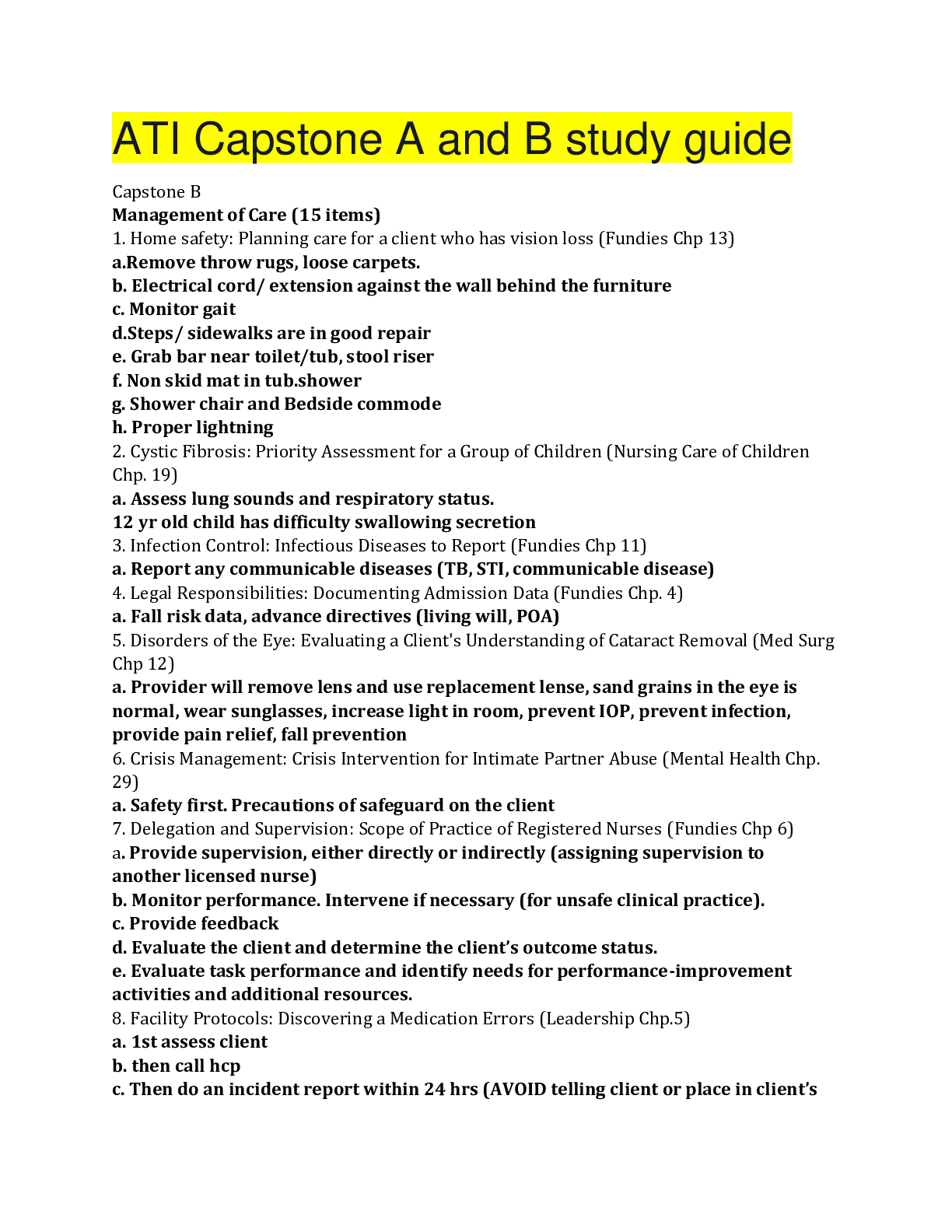*NURSING > QUESTIONS and ANSWERS > (complete) RN ATI Capstone Maternal Newborn and Women's Health 2016 (All)
(complete) RN ATI Capstone Maternal Newborn and Women's Health 2016
Document Content and Description Below
RN ATI Capstone Maternal Newborn and Women's Health 2016 Health Promotion and Maintenance - (12) Cancer Disorders: Risk Factors for Ovarian Cancer (Active Learning Template - System Disorder, RM A... MS RN 10.0 Chp 92) Age greater than 40 years Nulliparity or first pregnancy after 30 years of age Family history of ovarian, breast, or genetic mutation for hereditary nonpolyposis colon cancer (HNPCC) BRCA1 or BRCA2 gene mutations Diabetes mellitus Early menarche/late menopause History of dysmenorrhea or heavy bleeding Endometriosis High-fat diet (possible risk) Hormone replacement therapy Use of infertility medications Older adult clients following surgery for cancer Contraception: Contraindication to Intrauterine Device (Active Learning Template - Basic Concept, RM MN RN 10.0 Chp 1) RISKS/CONTRAINDICATIONS Best used by women in a monogamous relationship due to the risks of STIs Can cause irregular menstrual bleeding Risk of bacterial vaginosis, uterine perforation, or uterine expulsion Must be removed in the event of pregnancy CONTRA-INDICATIONS: Active pelvic infection, abnormal uterine bleeding, severe uterine distortion; for copper IUD also Wilson’s diseases and copper allergy Contraception: Evaluating Client Understanding of an Intrauterine Device (Active Learning Template - Medication, RM MN RN 10.0 Chp 1) A chemically active T-shaped device that is inserted through the cervix and placed in the uterus by the provider. Releases a chemical substance that damages sperm in transit to the uterine tubes and prevents fertilization. The most effective contraceptive methods at preventing pregnancy are the long acting reversible contraceptive (LARC) methods: implant and IUDs. IUDs can be used by nulliparous and multiparous women. CLIENT EDUCATION: The device must be monitored monthly by clients after menstruation to ensure the presence of the small string that hangs from the device into the upper part of the vagina to rule out migration or expulsion of the device Expected Physiological Changes During Pregnancy: Identifying a Client's Obstetrical History (Active Learning Template - Basic Concept, RM MN RN 10.0 Chp 3) Reproductive Uterus increases in size and changes shape and position. Ovulation and menses cease during pregnancy. Cardiovascular Cardiac output increases (30% to 50%) and blood volume increases (30% to 45% at term) to meet the greater metabolic needs. Heart rate increases during pregnancy beginning around week 5 and reaches a peak (10to15/min above pre-pregnancy rate) around 32weeks of pregnancy. Respiratory Maternal oxygen needs increase. During the last trimester, the size of the chest might enlarge, allowing for lung expansion, as the uterus pushes upward. Respiratory rate increases and total lung capacity decreases. Musculoskeletal Body alterations and weight increase necessitate an adjustment in posture. Pelvic joints relax. Gastrointestinal Nausea and vomiting might occur due to hormonal changes and/or an increase of pressure within the abdominal cavity as the pregnant client’s stomach and intestines are displaced within the abdomen. Constipation might occur due to increased transit time of food through the gastrointestinal tract and, thus, increased water absorption. Renal Filtration rate increases secondary to the influence of pregnancy hormones and an increase in blood volume and metabolic demands. The amount of urine produced remains the same. Urinary frequency is common during pregnancy. Endocrine The placenta becomes an endocrine organ that produces large amounts of hCG, progesterone, estrogen, human placental lactogen, and prostaglandins. Hormones are very active during pregnancy and function to maintain pregnancy and prepare the body for delivery Infections: Caring for a Client in Labor Who Had a Positive Group B Streptococcus Screen (Active Learning Template - System Disorder, RM MN RN 10.0 Chp 8) Administer intrapartum antibiotic prophylaxis to the following clients. Client who has GBS bacteriuria during current pregnancy Client who has a GBS-positive screening during current pregnancy Client who has unknown GBS status who is delivering at less than 37 weeks of gestation Client who has maternal fever of 38° C (100.4° F) Client who has rupture of membranes for 18 hr or longer Infertility: Risk Factors Affecting Fertility (Active Learning Template - Basic Concept, RM MN RN 10.0 Chp 2) ASSESSMENT Female AGE: Age greater than 35 years can affect fertility. DURATION OF INFERTILITY: More than 1 year of coitus without contraceptives. For women over the age 35 or who have a known risk factor, the recommendation is for 6months. MEDICAL HISTORY: Atypical secondary sexual characteristic, such as abnormal body fat distribution or hair growth, is indicative of an endocrine disorder. Assessment should include hormonal and adrenal gland disorders, as these can contribute to infertility. SURGICAL HISTORY: Particularly pelvic and abdominal procedures. OBSTETRIC HISTORY: Past episodes of spontaneous abortions. Other obstetric assessments should include an evaluation of hormone levels throughout the client’s cycle. This can provide information about anovulation, amenorrhea, and premature ovarian failure. GYNECOLOGIC HISTORY: Abnormal uterine contours or any history of disorders that can contribute to the formation of scar tissue that can cause blockage of ovum or sperm. SEXUAL HISTORY: Intercourse frequency, number of partners across the lifespan, and any history of STIs Labor and Delivery Processes: Behaviors During Latent Stage of Labor (Active Learning Template - Basic Concept, RM MN RN 10.0 Chp 11) Contractions Irregular, mild to moderate Frequency: 5 to 30 min Duration: 30 to 45 seconds Newborn Nutrition: Storage of Breast Milk (Active Learning Template - Basic Concept, RM MN RN 10.0 Chp 25) Breast milk can be stored at room temperature under very clean conditions for up to 8 hr. It can be refrigerated in sterile bottles for use within 8 days, or can be frozen in sterile containers in the freezer compartment of a refrigerator for up to 6months. Breast milk can be stored in a deep freezer for 12 months. Thawing the milk in the refrigerator for 24 hr is the best way to preserve the immunoglobulins present in it. It also can be thawed by holding the container under running lukewarm water or placing it in a container of lukewarm water. The bottle should be rotated often, but not shaken when thawing in this manner. Thawing by microwave is contraindicated because it destroys some of the immune factors and lysozymes contained in the milk. Microwave thawing also leads to the development of hot spots in the milk because of uneven heating, which can burn the newborn. Do not refreeze thawed milk. Used portions of breast milk must be discarded Nursing Care and Discharge Teaching: Care of a Newborn Who Is Uncircumcised (Active Learning Template - Basic Concept, RM MN RN 10.0 Chp 26) Remove the newborn from the restraining board, and swaddle to provide comfort. Monitor for bleeding and voiding per facility protocol. Apply gauze lightly to penis if bleeding or oozing is observed. Fan-fold diapers to prevent pressure on the circumcised area. Continued; [Show More]
Last updated: 1 year ago
Preview 1 out of 9 pages
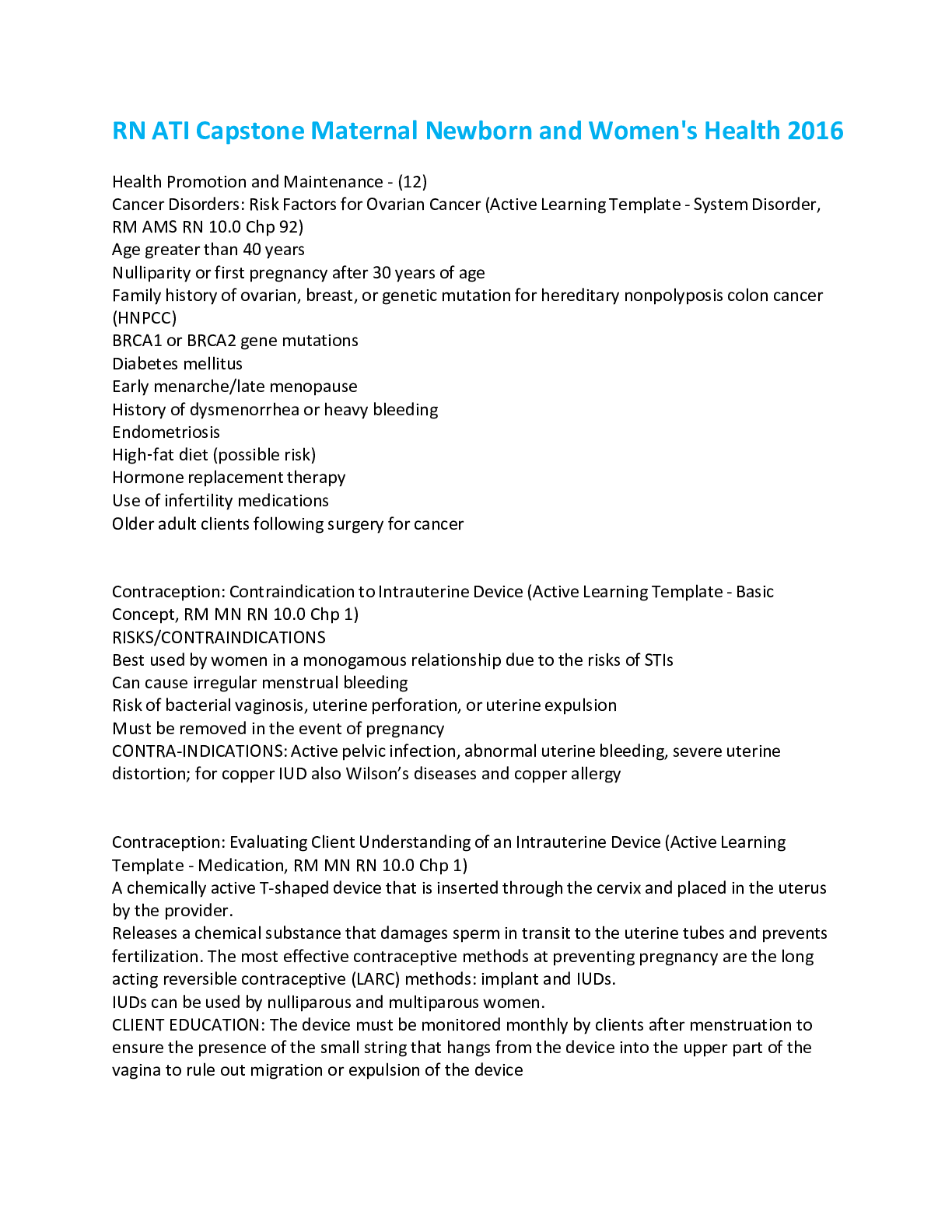
Reviews( 0 )
Document information
Connected school, study & course
About the document
Uploaded On
Apr 30, 2021
Number of pages
9
Written in
Additional information
This document has been written for:
Uploaded
Apr 30, 2021
Downloads
0
Views
38



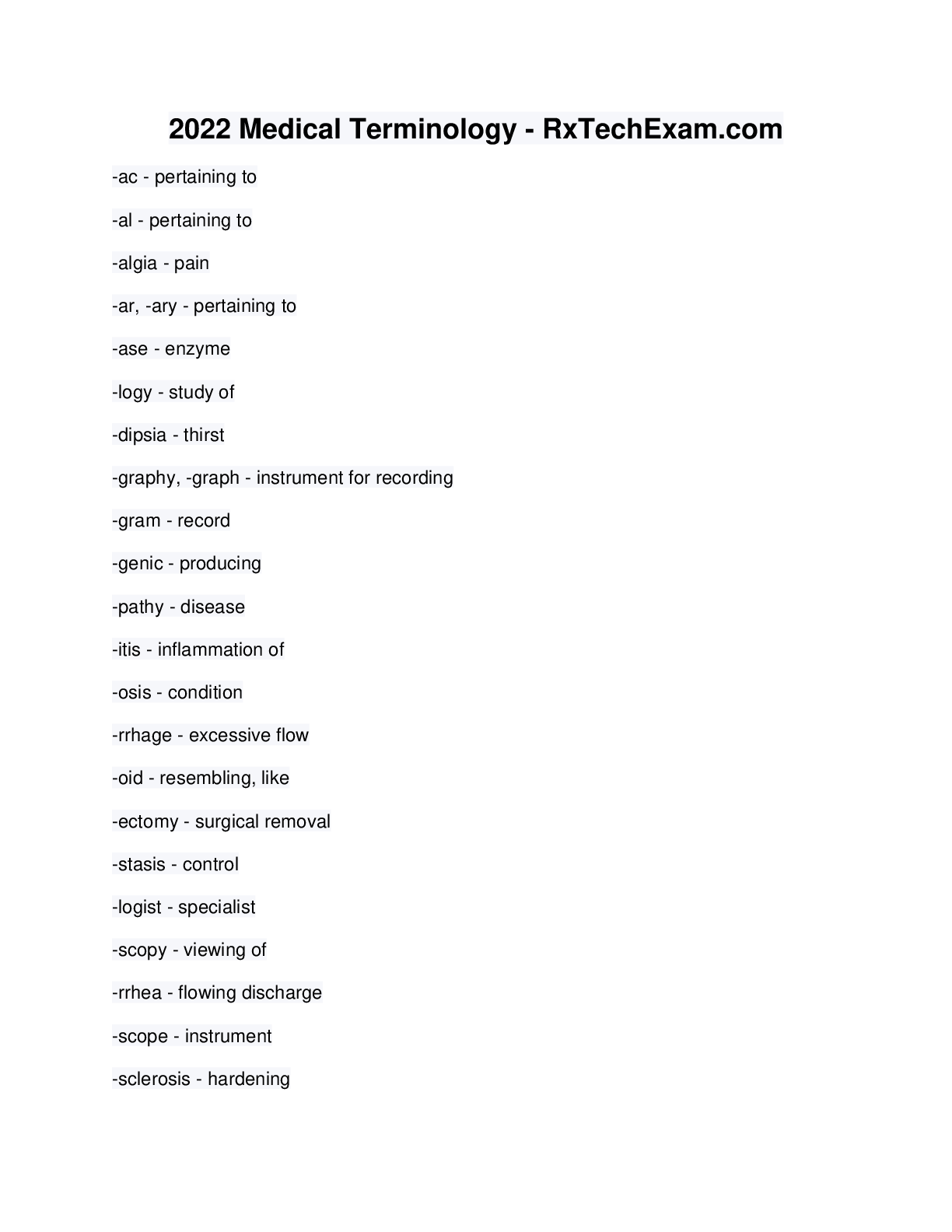

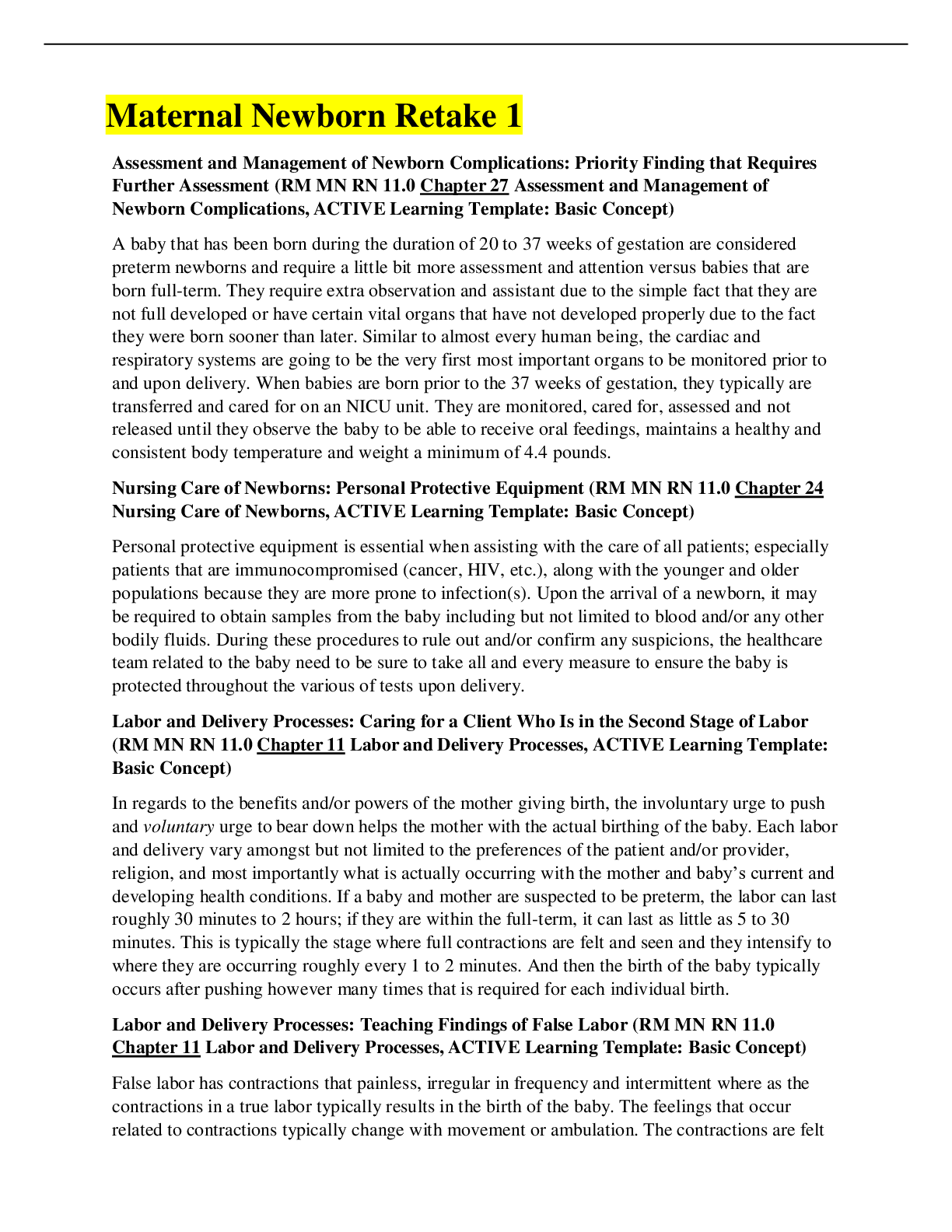

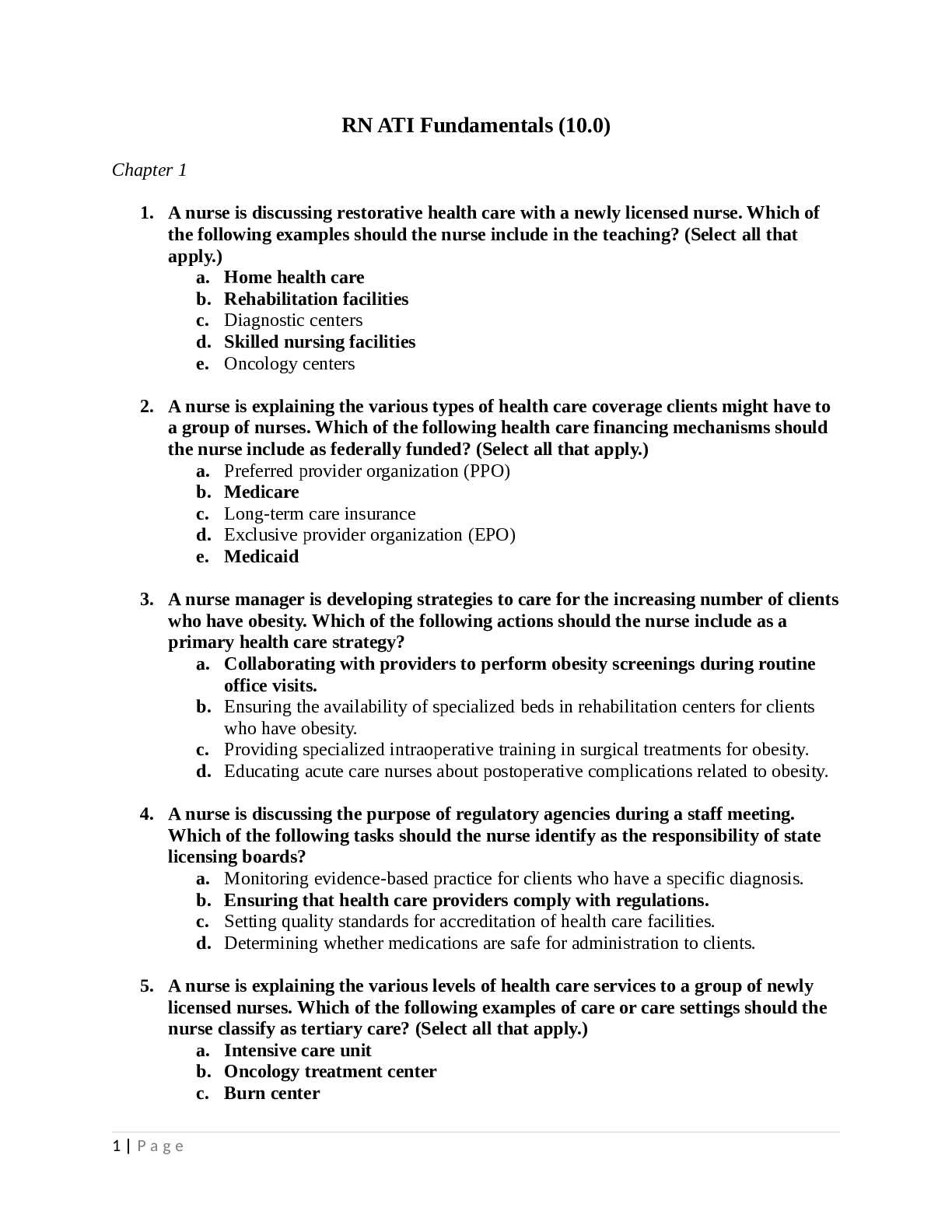

.png)
.png)




